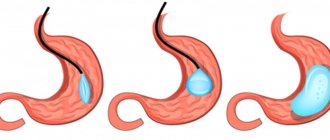Prevention of overweight and obesity
In the world, by 2021, the number of obese people has reached 2 billion. Today, according to statistics from the Russian Academy of Medical Sciences, more than half of the adult population of Russia (over 30 years old) suffers from excess body weight, and more than 20% from obesity.
The main criterion that determines the level of deviation of a patient’s weight from the norm is considered to be the body mass index.
Formula: BMI = m/h 2 , where m is body weight (kg), h is height (m).
The World Health Organization defines overweight individuals as having a BMI ≥ 25, and obese individuals as having a BMI ≥ 30.
The root cause of the development of excess body weight is associated with an imbalance in which the caloric content of a person’s diet prevails over the real energy needs of his body.
The global increase in the incidence of obesity is due to the following factors: consumption of high-calorie, fatty (energy-dense) foods, as well as low physical activity. These factors, in fact, are decisive in the development of the disease and tend to increase. This is due to the development of urbanization, transport infrastructure, increased employment of the population, which does not require significant physical activity, a decrease in the availability of quality food, etc.
Obesity is the cause of the development of a number of diseases of various organs and systems of the body:
- Diseases of the cardiovascular system: ischemic heart disease, atherosclerosis, arterial hypertension, ischemic stroke, myocardial infarction, etc.
- Non-insulin-dependent diabetes mellitus - type II diabetes
- Degenerative joint changes: osteoarthritis
- Increased risk of developing cancer
The greatest threat to human health and life is the so-called abdominal obesity, in which excess fat is concentrated in the abdominal area. With this type of obesity, the patient is most at risk of developing the diseases listed above.
Rational control of body weight allows you to avoid obesity and significantly reduce the risk of developing cardiovascular and other related diseases
Basic measures to prevent overweight and obesity
- Balance your diet. Exclude fatty foods: butter, lard, pork, smoked meats, mayonnaise, pasta, confectionery, wheat bread, cheese. Diversify your diet with vegetables and fruits. It is recommended to eat lean meat, poultry, bran bread, and a variety of cereals. Preference should be given to boiled and stewed food. Avoid fried foods.
- Food should be consumed slowly, chewing thoroughly. Also, you should not wash down your food with carbonated drinks, regardless of the calorie content of the latter. It has long been proven that “diet” cola, just like regular cola, helps increase appetite and eat more food.
- An alternative to cookies and sweets should be fruits or dried fruits.
- Workout. Running, swimming, fitness, hiking, badminton, tennis, football, etc.
- Consult a nutritionist to prescribe an individual nutrition plan to prevent excess body weight.
- Avoid factors that could potentially trigger eating large amounts of food. This could be: domestic quarrels, stress at work, frequent sitting in front of the TV, etc.
The population of East and Southeast Asia can be taken as an example of a healthy diet. The number of overweight people in this region is extremely small. And there are a number of explanations for this. 1) Asians have practically no bread, potatoes or pasta made from wheat flour in their diet; 2) the main side dish is rice or rice noodles; 3) traditional cutlery is chopsticks. This allows you to consume food most effectively - in small portions, and achieve satiety with a relatively smaller amount of food 4) In the culture of residents of China, Vietnam, Thailand and other countries in the region, it is not customary to eat on the go or while watching TV. Eating food is a separate process that Asians try not to combine with other activities. 5) Dessert as such is either absent or present in limited quantities. An alternative to desserts is fruit. 6) Small low-calorie portions of food 7) The basis of nutrition: soups, poultry, mushrooms, vegetables, seafood, pork and veal - in small quantities. 8) Approximate meal schedule: Breakfast (main meal) - 7-00, lunch - 12-00, light dinner – 19-00.
Healthy lifestyle: the basics of proper nutrition, prevention and treatment of obesity
Presentation
Look
From 01.03. until March 31, 2021, measures are being taken in the Lipetsk region to prevent overweight, reduce the incidence of obesity and promote the principles of healthy eating among the population.
Obesity is, first and foremost, a disease. And, like any disease, it is easier to prevent it than to eliminate its consequences.
Anyone can be obese. But there is a circle of people whose risk of obesity is higher, or it will be more severe than others. Among these persons:
- people with a family history, one or both parents or relatives who are overweight;
- due to their occupation, leading a sedentary lifestyle;
- food gourmets - lovers of eating a lot and tasty;
- persons suffering from diseases of the endocrine system, gastrointestinal tract, leading to obesity;
- those suffering from diseases that, with a possible increase in body weight, will be more severe (hypertension, coronary heart disease, lung diseases with respiratory failure);
- experiencing regular stress due to professional or domestic reasons;
- those who are at a certain life or physiological stage - pregnancy, lactation, menopause, old age;
- forced to take medications that lead to obesity - hormonal, psychotropic drugs, contraceptives.
For these categories of people, measures to prevent obesity will be very relevant.
Measures to prevent obesity:
Nutrition. Considering that the basis of any form of obesity, one way or another, is the nutritional (food) factor, attention should be paid to the quality and quantity of food consumed. But the main thing here is not to go to the other extreme - starvation. Contrary to many claims, fasting, especially dry fasting, without water, is not only useless, but also harmful.
Easily digestible carbohydrates and fats should be excluded from the diet, providing yourself with the optimal amount of protein, vitamins, and microelements. Limit the consumption of table salt (no more than 5 g per day). Firstly, it enhances taste and appetite, and secondly, it retains water in the body.
Limit alcohol consumption. Alcohol abuse is inextricably linked to obesity. Firstly, alcohol increases appetite - a person eats more. Secondly, it reduces the sensitivity of the saturation center in the hypothalamus. And ethyl alcohol itself is a high-energy and high-calorie product.
Physical activity. In order to balance the number of kilocalories incoming and expended, you need to reduce their intake or increase their consumption. And you can increase consumption through physical activity. Of course, exhausting sports training is not for everyone, especially if you have chronic diseases. But jogging, cycling, and sports games are suitable for many. And the most optimal preventative measure for this plan is swimming. Swimming movements help burn calories. In water, the weight (but not mass) of the body decreases. And when the body comes into contact with water, heat transfer increases, which also contributes to the breakdown of fat.
Normalization of the regime and improvement of psycho-emotional status. Sleep disturbances, negative emotions, and frequent stress can contribute to the release of certain biologically active substances that increase appetite and encourage food intake.
Treatment of concomitant diseases. Type 2 diabetes mellitus, insufficient thyroid function, gastroenterocolitis - everything that is potentially dangerous in terms of weight gain requires timely and adequate treatment.
Remember that preventing obesity is easier than treating it. Obesity prevention is in your hands. For effective prevention, it is necessary to achieve psychological balance, physical activity, control over the calorie content of foods, and a balanced attitude towards smoking and alcohol.
Health Center of Yeletsk City Clinic No. 2 on the street. Gagarina 5, invites everyone to undergo a set of examinations and receive an assessment of the functional and adaptive reserves of the body, consultation with a doctor at the Health Center on preserving and promoting health and creating a healthy lifestyle. Registration is made on the 6th floor in room 604. Opening hours from 8.00 to 15.00.
The material was prepared by head nurse N.A. Chursina.
Obesity. Modern approaches to the prevention of obesity.
Obesity, which is a pathological increase in body weight due to excessive accumulation of adipose tissue, is an independent chronic disease and, at the same time, the most important risk factor for non-insulin-dependent diabetes mellitus, arterial hypertension, atherosclerosis, cholelithiasis and some malignant neoplasms. Evidence of the causal relationship between obesity and serious metabolic disorders and cardiovascular diseases determines the importance of this problem for modern health care and allows us to talk about obesity as a serious threat to public health.
There is a steady increase in the prevalence of obesity worldwide. It has been shown that the main role in this is played by environmental factors, such as excessive consumption of high-calorie foods rich in fats and easily digestible carbohydrates, a chaotic diet with a predominance of plentiful meals in the evening and at night, and low physical activity. People tend to overeat fatty, high-calorie foods because such foods taste better due to the increased content of fat-soluble aromatic molecules and do not require thorough chewing. Active promotion of high-calorie foods on the market also plays an important role.
There are a large number of instrumental methods that make it possible to determine the content of adipose tissue (bioelectric impedance, dual-energy x-ray absorptiometry, determination of total water content in the body), but their use in widespread clinical practice is not justified. A more practical and simpler method of screening for obesity is to calculate the body mass index (BMI), which reflects the relationship between weight and height (weight in kilograms divided by the square of height in meters):
- less than 18.5 - underweight;
- 18.5-24.9 - normal body weight;
- 25-29.9 - overweight;
- 30-34.9—I degree obesity;
- 35.0-39.9 - obesity degree II;
- > 40 – III degree obesity.
It has been proven that even a moderately increased BMI leads to the development of hyperglycemia, arterial hypertension and dangerous complications. At the same time, determining BMI is a fairly simple manipulation that ensures timely prevention of these conditions. In general medical practice, it is recommended to determine BMI in all patients, followed by measures to reduce or maintain its normal level.
Waist circumference (WC) is also important in assessing abdominal obesity. Many researchers believe that this indicator plays an even greater role in the prognosis of cardiovascular complications and especially diabetes. Abdominal obesity is characterized by a special deposition of adipose tissue in the upper part of the body in the abdominal area.
Abdominal obesity is noted when WC is > 102 cm for men and > 88 cm for women (according to more stringent criteria - > 94 cm for men and > 80 cm for women).
Obesity prevention is referred to as primary prevention measures that are carried out among healthy people. These interventions are most effective when targeted at the entire population. They are based on the principles of healthy eating. Medical workers play a leading and coordinating role in these activities.
Primary prevention of obesity
Primary prevention of obesity should be carried out in case of genetic and family predisposition, with a predisposition to the development of diseases associated with obesity (type 2 diabetes mellitus, arterial hypertension, coronary heart disease), in the presence of risk factors for metabolic syndrome, with a BMI > 25 kg/m2, especially in women.
Secondary prevention of obesity
Secondary prevention also requires the active participation of family doctors. Their involvement of dietitians, nutritionists, and endocrinologists should contribute to the early detection of obesity and the prevention of its consequences and complications.
With a decrease in body weight in overweight and obese individuals, shortness of breath during physical activity decreases, physical performance increases, a hypotensive effect is observed, mood, ability to work, and sleep improve, which generally improves the quality of life of patients. At the same time, the severity of dyslipidemia decreases, and in the presence of diabetes mellitus, blood sugar levels decrease. Thus, as a result of weight loss, life prognosis improves and the risk of developing cardiovascular diseases decreases.
The basis of the method of reducing excess body weight is a calorie-balanced diet. It is necessary to explain to the patient the rules of a balanced diet, both in terms of calories and composition. Depending on the severity of obesity and taking into account the patient’s condition and professional activity, a hypocaloric diet is prescribed 15-30% below the physiological requirement.
Patients should be taught to distinguish between low-calorie, moderate-calorie, and high-calorie foods. Products recommended for unlimited consumption should provide a feeling of fullness (lean meats, fish), satisfy the need for sweets (berries, tea with sweetener), and create a feeling of fullness in the stomach (vegetables). The diet should be enriched with foods with lipolytic properties (cucumber, pineapples, lemon) and those that increase thermogenesis (green tea, still mineral water, seafood).
Weight loss programs must include not only dietary correction, but also mandatory aerobic physical training, which will improve or maintain the quality of life of patients. The most effective interventions for obesity include a combination of active counseling on nutrition, diet, and exercise with behavioral strategies designed to help the patient acquire appropriate skills.
The duration and intensity of exercise depends on the state of the cardiovascular system. It is necessary to examine the patient and determine tolerance to physical activity. The most accessible and simple method of physical activity is measured walking or measured running at a moderate pace. At the same time, regularity of classes is especially important, which requires strong-willed efforts and a psychological attitude.
It has been shown that physical activity leads to a moderate increase in energy expenditure and contributes to changes in energy balance. But sometimes physical activity, although undoubtedly beneficial, does not provide a significant reduction in body weight, which is explained by the redistribution of fat mass (it decreases) towards an increase in muscle mass. However, despite a slight overall decrease in body weight with increased physical activity, the amount of visceral fat decreases, which is extremely important for reducing the risk of developing concomitant pathologies and improving the life prognosis of obese patients.
The primary goal is a 10% reduction in body weight over 6 months, which leads to a 10% reduction in overall mortality. In almost 95% of cases, it is not possible to reduce body weight for a long time, since obesity is perceived by many patients and, unfortunately, doctors, as before, as a cosmetic rather than a medical problem. This is why most obese patients self-medicate. According to the International Obesity Task Force (IOTF), every third obese patient tries to reduce body weight on their own, but without significant effect.
Both the nutritional system and physical activity require careful, well-thought-out and strictly individual dosing. But often, when a doctor expresses a desire to lose weight, he does not make specific recommendations, leaving the desire to lose weight as nothing more than a wish. It is also not fully realized that the treatment of obesity, like, by the way, the treatment of any other chronic disease, should be continuous. That is, a set of measures aimed at actively reducing excess body weight should in no case end with the patient returning to the usual diet and lifestyle for him and his family. It should smoothly transition into a set of measures aimed at maintaining the achieved result.
Mandatory measures to prevent obesity
- Regular assessment of body weight of all patients, determination of waist circumference. If these indicators are within normal limits or decrease, the patient should be informed and his behavior approved.
- Assessment of the nature of nutrition and eating habits that are prognostically significant for the development of obesity, which is preferably carried out in all patients, regardless of BMI.
- Informing patients about the dangers of excess body weight, especially the risk of developing cardiovascular diseases.
- Patients with a BMI above 30 should be advised to reduce body weight to 27 or below as a long-term goal. In this case, the reduction in body weight should be no more than 0.5-1 kg per week. If dietary changes are not effective enough, a low-calorie diet is recommended.
- Constant monitoring and support of the patient during obesity treatment. It is advisable to re-measure BMI weekly or at least once every two weeks, check the food diary, express approval and encouragement to the patient, and observe an increase in physical activity and physical activity.
List of topics to discuss with patients in order to successfully change eating behavior
- Keeping a food diary.
- Losing weight is a long-term lifestyle change.
- Changing eating habits.
- The role of physical activity in the treatment of obesity and ways to increase it.
- Analysis of situations that provoke overeating and search for ways to eliminate them.
- Why is it so important to plan your menu for the day?
- How to read food labels correctly.
- The influence of stress and negative emotions on appetite.
- Food as a way to deal with negative emotions, searching for alternative ways to deal with them.
- Ability to control feelings and emotions
- Drug therapy is promising for secondary prevention and treatment of obesity.
Treating obesity is no less challenging than treating any other chronic disease. Success in this case is largely determined by the persistence in achieving the goal not only of the patient himself, but also of the doctor. The main task is a gradual change in the patient’s unhealthy lifestyle, correction of a disrupted eating stereotype, reducing the dominant role of food motivation, and eliminating incorrect connections between emotional discomfort and food intake.











